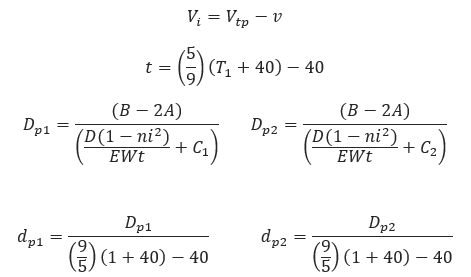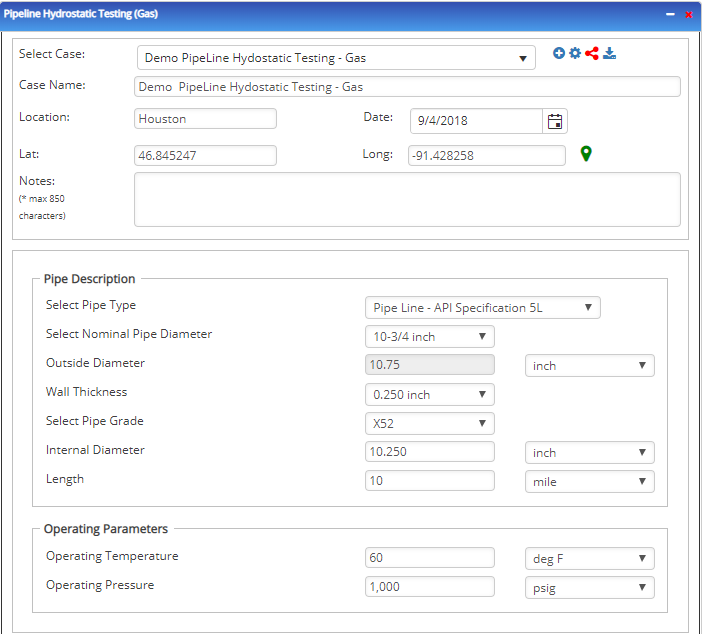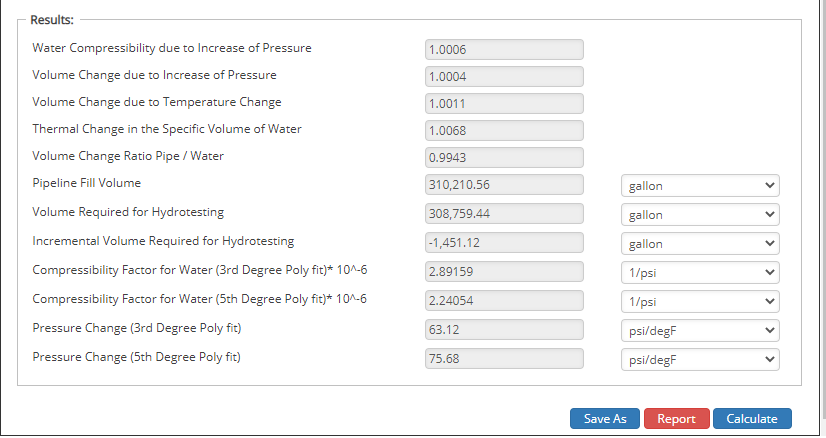Pipeline Hydrostatic Testing
Hydrostatic testing is a method to determine strength, expose defects, expose leak & validate integrity of the vessel. Typically, tests are conducted at 125% of MAOP.
These tests are limited to defects that are ready for failure such as cracks. The test pressure must be adjusted for the related allowable stress at the design temperature. This requires adjustments during the testing phase due to ambient temperature conditions.


𝐹𝑝𝑝 − Volume Change due to Increase of Pressure
𝐷 − Pipe Diameter[in]
𝑊𝑡 − Pipe Wall Thickness[in]
𝑃 − Test Pressure[psi]
𝑇1 − Test Temperature[°F]


𝑣 − Pipe Fill Volume[gal]
𝐿 − Pipe Length[mi]

𝑉𝑡𝑝−Volume Required for Hydro Testing[gal]
𝑉𝑖−Incremental Volume Required for Hydro Testing[gal]



These tests are limited to defects that are ready for failure such as cracks. The test pressure must be adjusted for the related allowable stress at the design temperature. This requires adjustments during the testing phase due to ambient temperature conditions.

𝑃 − Test Pressure[psi]
𝐹𝑤𝑝 − Water Compressibility due to Increase of Pressure

𝐹𝑝𝑝 − Volume Change due to Increase of Pressure
𝐷 − Pipe Diameter[in]
𝑊𝑡 − Pipe Wall Thickness[in]
𝑃 − Test Pressure[psi]
𝑇1 − Test Temperature[°F]
𝐹𝑝𝑡 − Volume Change due to Temperature Change

𝐹𝑝𝑤𝑡 − Volume Change Ratio Pipe/Water
𝐹𝑤𝑡 − 𝑤𝑡 Factor Lookup Table
𝑣 − Pipe Fill Volume[gal]
𝐿 − Pipe Length[mi]
𝑉𝑡𝑝−Volume Required for Hydro Testing[gal]
𝑉𝑖−Incremental Volume Required for Hydro Testing[gal]

𝐶1 − Compressibility Factor for Water(3rd degree poly fit)[in3/in3/gal]
𝐶2 − Compressibility Factor for Water(5th degree poly fit)[in3/in3/gal]
𝑑𝑝1 − Pressure Change(3rd degree poly fit)[psi/℉]
𝑑𝑝2 − Pressure Change(5th degree poly fit) [psi/℉]
𝐸 − Modulus of Elasticity
𝑡 − Test Temperature[℉]
𝑛𝑖 − Poisson-′.s Ratio(ni = 0.3)
𝐴 − Coefficient of Thermal Expansion of Pipe Material[1/℉]
Input Parameters
- To create a new case, click the “Add Case” button
- Select the Pipeline Hydrostatic Testing application from the Pipeline Testing module.
- Enter Case Name, Location, Date and any necessary notes.
- Fill out all required fields.
- Make sure the values you are inputting are in the correct units.
- Click the CALCULATE button.
- Nominal Pipe Size(in):(0.625” – 48”)
- Wall Thickness(in):(0.068”- >2”)
- Outside Diameter(in)
- Internal Diameter(in)
- Test Pressure(psi)
- Test Temperature (°F)
- Pipeline Length(miles)

Outputs/Reports
- View the results.
- If an input parameter needs to be edited be sure to hit the CALCULATE button after the change.
- To SAVE, fill out all required case details then click the SAVE button.
- To rename an existing file, click the SAVE As button. Provide all case info then click SAVE.
- To generate a REPORT, click the REPORT button.
- The user may export the Case/Report by clicking the Export to Excel/PowerPoint icon.
- To delete a case, click the DELETE icon near the top of the widget.
- Water Compressibility due to Increase of Pressure
- Volume Change due to Increase of Pressure
- Volume Change due to Temperature Change
- Volume Change Ratio Pipe/Water, Pipeline Fill Volume(gal.)
- Volume Required for Hydrotesting(gal.)
- Incremental Volume Required for Hydrotesting(gal.)
- Compressibility Factor for Water (3rd Degree Poly fit) (in³/in³/psig) x10-6
- Compressibility Factor for Water (5th Degree Poly fit) (in³/in³/psig) x10-6
- Pressure Change (3rd Degree Poly fit) (psi/°F)
- Pressure Change (5th Degree Poly fit) (psi/°F).

